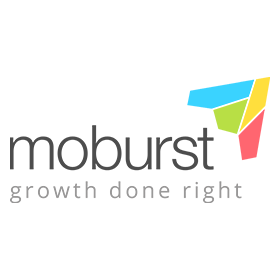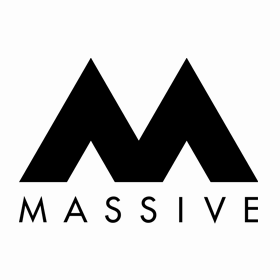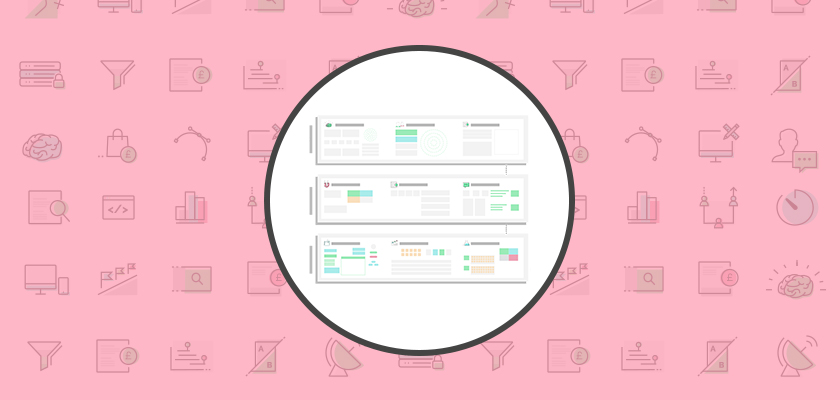
Using Content Ideas to Map Growth Opportunities
At this point, we’ve got a good understanding of what your business does, and who it needs to target. We’ve built out the key marketing messages using the SWST test…
Next up, we’re diving into part five of our nine-part framework where we show you how to map out your content themes and engage users to the max!
In this short post, we’re giving you a quick look at our Content Ideas exercise — it’s a short exercise and will help generate content ideas around the kinds of questions your customers might be asking.
Why You Should Plan Your Content?
When you’re a business, it’s not enough to just have a website. You need the right kind of content too. It doesn’t matter if your site is beautiful or easy to use if customers don’t find what they are looking for on it. That can often be because it wasn’t anything there in the first place!
Carefully planning your content will help you stand out from competitors who might have more time and resources to spend on their marketing strategy. It’ll also ensure that visitors stay engaged with your brand online which means higher conversion rates and happier customers!
Content mapping is a perfect way to outline specific content themes that relate to and support your customer’s journey. The following exercise can help with this by using two simple tools that will allow you to pick out search queries related to your product or service and turn them into robust content.
How to Use Our Content Ideas Map to Start a Growth Map for Your Business
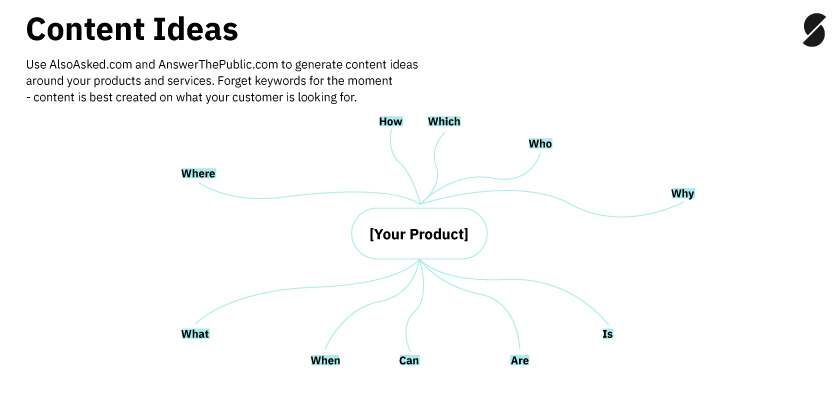
In the graphic above, you’ll see a blank mind map (also called “spider web maps or concept maps) with spaces to add your core products/services. We start here and then mine different questions that your audience is asking.
We use a structured series of questions to understand what your potential customers are asking. We start with the basics: “How?” and move on from there, branching out into different types like “where”, “what”, or even why do they need something in the first place?
We used AlsoAsked.com and AnswerThePublic.com to find questions we can answer with our content!
When it comes to the product or service you choose to focus on, be as specific and detailed as possible. This will help potential customers make more informed decisions about which solution is right for them. You can then create more meaningful, detailed content by digging a little deeper.
How can you make your content more relevant? For instance, if an accountancy firm is trying to get the attention of its target audience they could map out a plan based on “accountants” but this may not be enough because there are many different types.
Mapping out exactly what type or niche would give your prospects and clients something specific that interests them gives businesses better odds at catching people’s interest.
Instead, if you were to look at the common search queries related to “tax audits” or “management reports,” your audience has a higher likelihood of being more relevant to a specific group of users.
Take a look at this exercise in action, where we’ve used “eCommerce fraud” as an example.
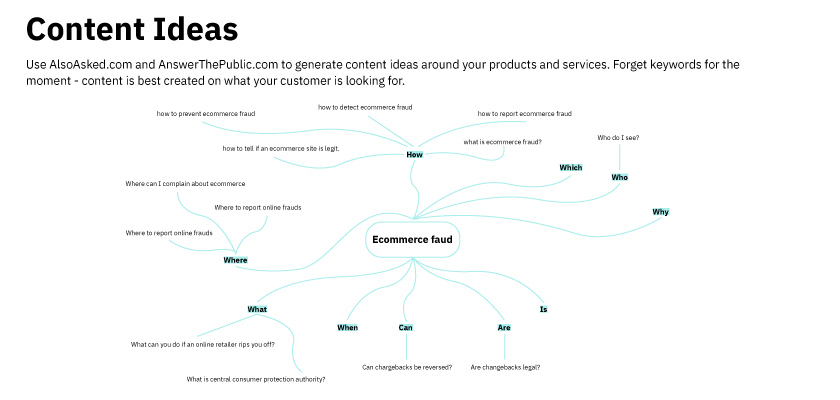
To find out which questions your ideal customers are searching for, we use two tools; AlsoAsked.com and AnswerThePublic to get an idea of what people might be looking up on Google or Bing without actually typing anything in! Both tools have free versions available to use.
They both work in a similar way: they mine Google search results for related searches before compiling a massive list of relevant questions to your product, service, or industry.
The phrase “eCommerce fraud” generates questions that we could use for content marketing as we’ve done above. These tools are a great way to brainstorm creative ideas and test them out before writing articles or creating graphics!
For example:
- How to prevent eCommerce fraud?
- How to detect eCommerce fraud?
- Where to report eCommerce fraud?
- What can you do if you get scammed online?
- Where can I complain about eCommerce?
We then build a selection of potential options for quality content, with the help of the best suggestions.
As you continue working through this exercise, the deeper your dive becomes. The more valuable questions become!
A simple search of the term “eCommerce fraud” led us to a list of ultra-specific topics, including:
- Can chargebacks be reversed?
- Are chargebacks legal?
- What is the Central Consumer Protection Authority?
- And more…
As an industry expert, you can map customer’s journeys to the appropriate content.
The secret to content marketing is not in the creation of new topics or titles, but rather in utilizing what your customers want. Create content that provides real answers to questions they may have. You can take this idea further by building blogs and newsletters around customer needs.
Try the Growth Mapper Today
We’ve designed each section of our Growth Mapper framework around a critical part of your business growth. We start with the basics and drill down into the details, giving you a clear picture of the opportunities and challenges moving forward.
Download the free workbook here to start your own content ideas map. You can also read our Coherent and Cohesive Content article as further reading. Also, read more about The Growth Mapper SWST Test and How to Start Growth Mapping With Customer Profiling articles.


